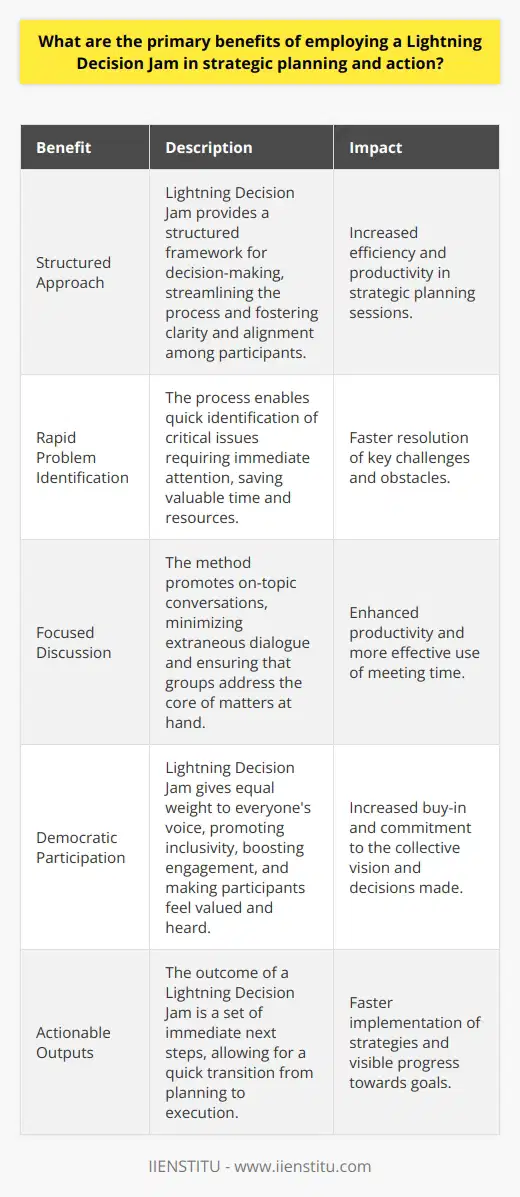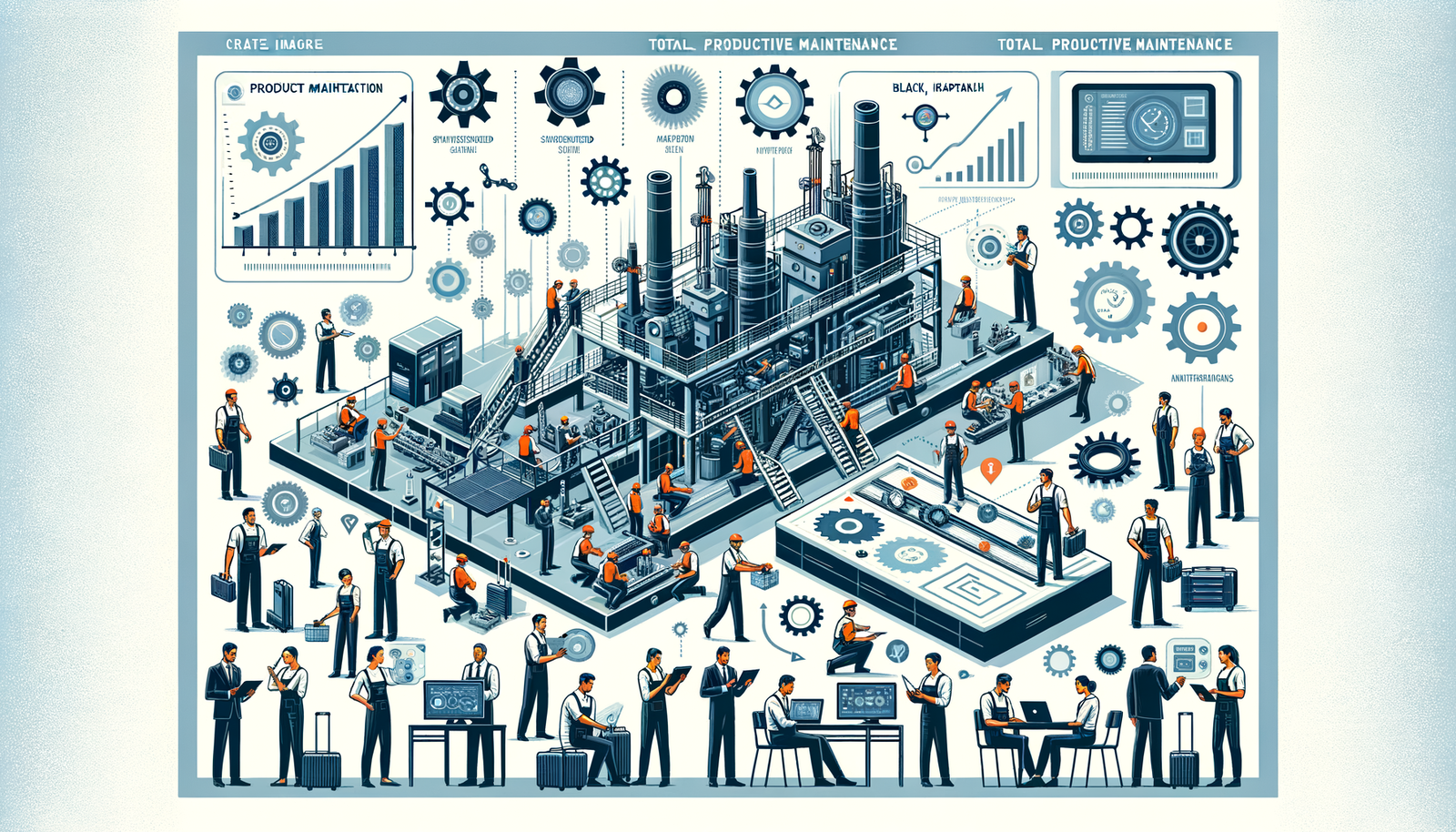
In today's fast-paced business landscape, the ability to make swift and effective decisions is paramount. This agility can be the difference between thriving and merely surviving. The Lightning Decision Jam (LDJ) process has emerged as a transformative approach to decision-making and problem-solving, offering a novel way to navigate the complexities and demands of modern organizational life. It offers a way to bypass the often sluggish pace of traditional meetings and jump straight to solutions and actions. In this article, we explore the LDJ method, its embedded strategies for swift decision-making, effective action planning, and innovative problem-solving, as well as the tangible benefits it can deliver.
I. Introduction to Lightning Decision Jam
A. Definition of the Lightning Decision Jam process
The LDJ is a structured, time-boxed workshop designed to help teams break through decision paralysis and execute solutions quickly and collaboratively. It takes participants through a series of steps that transform undefined challenges into actionable steps. The central tenet of the LDJ is the use of constraint: by limiting the time for each activity, it promotes a focus and energy that traditional meetings often lack.
I remember my first experience with the LDJ process. As a project manager at a tech startup, I was struggling with a team that seemed to be stuck in an endless cycle of meetings without any tangible progress. We were facing a critical decision about the direction of our product, and despite hours of discussion, we couldn't seem to reach a consensus.
That's when our CEO introduced us to the LDJ process. At first, I was skeptical. How could we possibly make a decision of this magnitude in such a short timeframe? But as we worked through the process, I was amazed at how quickly we were able to cut through the noise and focus on what really mattered.
By the end of the session, we not only had a clear decision, but also a detailed action plan for how to implement it. It was a turning point for our team, and from that moment on, the LDJ became a regular part of our decision-making toolkit.
B. Overview of the importance of swift decision-making and effective action planning in modern organizations
Organizations today face unprecedented challenges and opportunities that require rapid response. Swift decision-making enables teams to act quickly, seizing opportunities and mitigating issues before they escalate. Effective action planning turns these decisions into a clear roadmap, ensuring cohesive team effort and strategic allocation of resources.
In his seminal work, "The Fifth Discipline: The Art and Practice of the Learning Organization", Peter Senge emphasizes the importance of swift decision-making in modern organizations. He argues that in an increasingly complex and rapidly changing world, organizations that can make decisions quickly and effectively are more likely to succeed (Senge, 2006, p. 87).
Similarly, in "The Lean Startup: How Today's Entrepreneurs Use Continuous Innovation to Create Radically Successful Businesses", Eric Ries highlights the critical role of effective action planning. He contends that the ability to quickly turn decisions into actionable plans is a key characteristic of successful startups (Ries, 2011, p. 103).
C. Prevalence of innovative problem-solving in competitive environments
In competitive environments, the ability to not only address problems quickly but do so innovatively can create a significant advantage. It requires a framework that allows for free-thinking yet directs it towards actionable solutions. The LDJ provides such a framework, prompting teams to think outside the box within the confines of a structured process.
A study published in the "Journal of Product Innovation Management" found that companies that foster a culture of innovative problem-solving are more likely to achieve sustained competitive advantage. The researchers concluded that "the ability to solve problems creatively is a critical skill for organizations operating in today's dynamic and competitive environments" (Hülsheger, Anderson, & Salgado, 2009, p. 1128).
D. The objectives of the blog: discussing LDJ strategies and their benefits for swift and efficient decision-making
The goal of this blog is to dissect the LDJ process, understand how it facilitates swift and effective decision-making, and evaluate the benefits and impacts it has on modern organizations. Incorporating elements from a book like "Sprint: How to Solve Big Problems and Test New Ideas in Just Five Days" by Jake Knapp, John Zeratsky, and Braden Kowitz or an online MBA course can further enrich one's expertise in this innovative training methodology.
II. Understanding the LDJ Framework
A. Detailed Exploration of the Lightning Decision Jam Process
The Lightning Decision Jam (LDJ) process commences with an initial phase of problem framing and identification. Here, team members openly discuss and acknowledge various challenges, ensuring that these issues are brought to light without any premature judgments or critiques. This inclusive approach allows for a comprehensive understanding of the problems at hand.
Following this, the process moves into a creative solution brainstorming stage. In this phase, participants are encouraged to freely propose a multitude of ideas, fostering an environment of innovation and creativity. The emphasis is on quantity and diversity of thought, rather than immediate practicality or feasibility. This ensures a broad spectrum of solutions, encompassing both conventional and out-of-the-box ideas.
The decision-making phase then takes center stage. Here, the focus shifts to evaluating and prioritizing the previously generated ideas. The criteria for this prioritization include the potential impact of the solutions and their ease of implementation. This phase is critical in distilling the multitude of ideas into a manageable and actionable shortlist.
Finally, the process culminates with the action planning stage. In this concluding phase, the most promising ideas are transformed into a tangible plan of action. Specific tasks and responsibilities are assigned, ensuring clarity and accountability. This step is vital for converting theoretical solutions into practical steps that can be implemented by the team.
In "The Wisdom of Crowds: Why the Many Are Smarter Than the Few and How Collective Wisdom Shapes Business, Economies, Societies and Nations", James Surowiecki argues that the diverse perspectives and independent judgments of a group can lead to better decisions than those made by any single member of the group (Surowiecki, 2005, p. 10). This principle is at the heart of the LDJ process, which leverages the collective intelligence of the team to generate and refine ideas.
B. The Impact of Time Constraints on Productivity and Efficiency
Time constraints are a pivotal element in the LDJ framework, serving a dual purpose of enhancing focus and efficiency. By setting strict time limits for each phase of the LDJ, teams are encouraged to avoid the pitfalls of prolonged discussions and indecisiveness, commonly referred to as analysis paralysis.
These constraints necessitate concise and targeted contributions from participants, fostering a more streamlined and focused discussion. This approach ensures that the team's collective energy and intelligence are utilized effectively, leading to a more productive and time-efficient workflow.
In "Scarcity: Why Having Too Little Means So Much", Sendhil Mullainathan and Eldar Shafir discuss how scarcity, including time scarcity, can actually enhance focus and productivity. They argue that when we have less of something, we tend to use it more effectively (Mullainathan & Shafir, 2013, p. 5). This principle is leveraged in the LDJ process, where the scarcity of time drives teams to be more efficient and focused.
C. Techniques for Successfully Navigating Teams Through the LDJ Process
Effective facilitation is key to navigating teams through the LDJ process. Facilitators must possess a deep understanding of the LDJ's objectives and structure to guide the team effectively.
An adept facilitator plays a crucial role in steering the group through each phase of the LDJ. They encourage active and balanced participation from all team members, ensuring that every voice is heard. Simultaneously, they keep the process on track, adhering to the set time constraints and maintaining a focus on the end goal.
Balancing the need for creative ideation with a drive towards practical decision-making and action planning is a delicate task. The facilitator must ensure that while creativity is nurtured, it is also channeled effectively towards actionable outcomes. This balance is essential for the success of the LDJ process, ensuring that it yields tangible results and actionable plans.
In "The Art of Facilitation: The Essentials for Leading Great Meetings and Creating Group Synergy", Dale Hunter, Stephen Thorpe, Hamish Brown, and Anne Bailey provide a comprehensive guide to effective facilitation. They emphasize the importance of a facilitator's ability to create a safe and inclusive environment, manage group dynamics, and guide the group towards its objectives (Hunter, Thorpe, Brown, & Bailey, 2007, p. 22).
III. Employing LDJ Strategies for Swift Decision-Making
A. Practical Approaches within the LDJ Framework
The Lightning Decision Jam (LDJ) methodology incorporates several practical strategies designed to streamline and energize the decision-making process. One such strategy is silent ideation, a technique that allows individuals to generate ideas independently without influence or interruption from others. This approach ensures a diversity of thoughts and minimizes the risk of dominant voices overshadowing quieter team members.
Another key strategy is dot voting. This method is used to prioritize ideas in a democratic and visual manner. Each team member is given a set of dots to allocate to the ideas they find most compelling. This not only speeds up the decision-making process but also ensures that the ideas with the broadest support are prioritized.
Time-boxing is also integral to the LDJ framework. By allocating a fixed amount of time for each discussion or activity, the process remains focused and efficient. This approach helps to maintain momentum and keeps discussions from becoming stagnant or overly lengthy.
In "Decision Making and Problem Solving Strategies", John Adair presents a variety of practical strategies for effective decision-making. He highlights the importance of techniques like silent ideation and dot voting in ensuring that all team members have an equal opportunity to contribute and that decisions reflect the collective wisdom of the group (Adair, 2010, p. 113).
B. Avoiding Pitfalls in Decision Jams
To navigate around common pitfalls such as groupthink and decision fatigue, LDJ employs several unique techniques. One such technique is the use of breakout discussions. By dividing larger groups into smaller teams, a more diverse range of ideas can be explored, and quieter voices can be amplified.
Rotating facilitation roles is another strategy used to inject fresh energy and perspective into the process. This approach ensures that no single viewpoint dominates and that new facilitation styles can invigorate the process.
Reframing problems as questions is also a valuable technique. This not only encourages creative thinking but also prevents the team from becoming too fixated on any one issue or perspective, maintaining a dynamic and open-minded atmosphere.
In "Groupthink: Psychological Studies of Policy Decisions and Fiascoes", Irving Janis analyzes the phenomenon of groupthink and its detrimental effects on decision-making. He suggests strategies for avoiding groupthink, including the use of outside experts, the encouragement of dissent, and the rotation of leadership roles (Janis, 1982, p. 262). These strategies align closely with the techniques employed in the LDJ process.
C. Facilitating Discussions for Rapid Consensus
Achieving swift consensus in an LDJ session requires a facilitator who is adept at steering discussions in a constructive and inclusive manner. One effective technique is the use of fist to five voting. This method allows team members to express their level of agreement with a proposal, ranging from complete disagreement (fist) to full agreement (five fingers). It's a quick and clear way to gauge consensus.
For more contentious or complex topics, the use of resolution rooms can be particularly effective. In these settings, smaller groups focus on resolving specific disagreements or challenges, ensuring that these issues are addressed thoroughly without derailing the broader group's progress.
Overall, the successful implementation of LDJ strategies hinges on the facilitator's ability to balance structure with flexibility, ensuring that discussions remain focused yet fluid, and leading the team towards effective and rapid decision-making.
In "The Facilitator's Guide to Participatory Decision-Making", Sam Kaner provides a wealth of strategies for facilitating effective group decision-making. He emphasizes the importance of inclusive and participatory processes, as well as the role of the facilitator in managing group dynamics and guiding the group towards consensus (Kaner, 2014, p. 32).
IV. Advantages of Quick and Effective Action Planning in the LDJ Framework
A. Transformative Impact of LDJ on Generating Action-Oriented Outcomes
The Lightning Decision Jam (LDJ) methodology drastically shifts the dynamics of action planning, making it markedly more effective due to its focus on action-oriented outcomes. In the LDJ setting, decisions are not left as abstract concepts but are swiftly translated into specific, assignable tasks, each with a clearly defined owner and a deadline.
This structured approach cuts through the typical delays associated with conventional planning and decision-making processes. It allows teams to rapidly move from ideation and discussion phases to tangible implementation, thereby minimizing the downtime that often occurs when transitioning from planning to action in traditional settings.
In "Making Things Happen: Mastering Project Management", Scott Berkun emphasizes the importance of action-oriented planning. He argues that the best plans are those that are designed with implementation in mind, with clear tasks, owners, and deadlines (Berkun, 2008, p. 27). This principle is at the core of the LDJ methodology.
B. Enhancing Project Momentum and Boosting Team Morale through Swift Action Planning
The rapidity and efficiency inherent in the LDJ action planning process yield significant benefits for both project momentum and team morale. Quick action planning leads to an immediate sense of progress as plans swiftly move from theoretical stages to actionable steps. This fast-paced transition is vital for maintaining the energy and direction of the project, preventing the common scenario of projects stalling post-meeting.
Moreover, the tangible sense of progress and achievement fostered by seeing ideas come to life not only energizes the team but also enhances their collective morale. This sense of accomplishment is a powerful motivator and helps in building a cohesive and dedicated team, committed to the success of the project.
In "Drive: The Surprising Truth About What Motivates Us", Daniel Pink identifies mastery, autonomy, and purpose as the key drivers of intrinsic motivation. He argues that the sense of progress and accomplishment that comes from seeing one's work come to fruition is a powerful motivator (Pink, 2009, p. 109). This aligns with the benefits of swift action planning in the LDJ process, which provides teams with a clear sense of progress and achievement.
C. Comparative Analysis: LDJ Outcomes versus Traditional Meeting Structures
When contrasting the outcomes achieved through LDJ with those of traditional meeting structures, several key distinctions become evident. Traditional meetings are often criticized for their tendency to be unfocused and inefficient, frequently leading to protracted discussions with limited tangible outcomes. In contrast, the LDJ framework is meticulously designed to be outcome-centric and time-efficient. This focus ensures that meetings are not only more engaging, fostering a higher degree of participation, but also more effective in producing actionable results.
One of the primary advantages of LDJ is the speed at which decisions are made and executed. This rapid decision-making process is in stark contrast to the often slow and cumbersome nature of traditional meetings, where decisions can be delayed by prolonged discussions, indecisiveness, or lack of clear direction. Additionally, LDJs tend to result in a higher level of satisfaction among participants. This is largely because the structured, action-focused approach of LDJ ensures that every participant's voice is heard and that decisions are made democratically, leading to a greater sense of ownership and commitment to the outcomes.
In summary, the LDJ framework offers a more structured, efficient, and democratic approach to decision-making and action planning compared to traditional meeting structures. This approach not only accelerates the implementation of decisions but also significantly enhances team dynamics and project outcomes.
In "Death by Meeting: A Leadership Fable...About Solving the Most Painful Problem in Business", Patrick Lencioni highlights the many pitfalls of traditional meetings. He argues that most meetings are inefficient, unfocused, and fail to produce meaningful outcomes. As a counterpoint, he presents a model for effective meetings that bears many similarities to the LDJ process, with a focus on structure, engagement, and action (Lencioni, 2004, p. 217).
V. The Role of Innovative Problem-Solving in LDJs
A. Encouraging creative solutions within a time-bound framework
LDJs are designed to encourage creative solutions by setting a pace that energizes participants and breaks conventional thinking patterns. The sheer velocity of the process can propel teams towards novel approaches that might not emerge in a more leisurely paced environment.
B. Methods for unleashing team innovation during an LDJ
To unleash team innovation, LDJ facilitators may incorporate various creative exercises like analogy thinking, role-storming, or reverse brainstorming. This shift in approach can unlock new perspectives and lead to groundbreaking solutions.
In "Thinkertoys: A Handbook of Creative-Thinking Techniques", Michael Michalko presents a variety of techniques for stimulating creative thinking. Many of these techniques, such as the use of analogies, random stimuli, and role-playing, can be effectively integrated into the LDJ process to encourage innovative problem-solving (Michalko, 2006, p. 130).
C. Examples of innovative outcomes achieved through LDJs
LDJs have been instrumental in producing innovative outcomes across sectors. For instance, a tech company may use an LDJ to pivot their product strategy effectively, while a manufacturing firm might resolve a longstanding efficiency issue within a singular LDJ session.
I recall a particularly impactful LDJ session I facilitated for a client in the healthcare industry. The organization was facing a complex challenge related to patient flow in their hospital. Despite numerous
Frequently Asked Questions
What are the primary benefits of employing a Lightning Decision Jam in strategic planning and action?
Lightning Decision Jam and Strategic Planning
A Lightning Decision Jam presents a structured approach. It streamlines decision-making. It yields clarity and fosters alignment. These benefits are crucial in strategic planning.
Rapid Problem Identification
This process quickly pinpoints issues. Participants highlight matters needing immediate attention. Efficient problem identification saves valuable time.
Focused Discussion
The method promotes on-topic conversations. Extraneous dialogue lessens. Groups address the core of matters. This ensures productivity during sessions.
Encourages Democratic Participation
Everyone's voice gains equal weight. This inclusivity boosts engagement. Participants feel valued and heard. The outcome is a collective vision.
Reduces Decision Paralysis
Participants face fewer barriers to consensus. Options simplify into manageable actions. Clear paths forward emerge. Deliberation gives way to action.
Enhances Team Collaboration
Teamwork strengthens through a shared process. It leads to better communication. Trust develops among members. The result should be synergy.
Time-Efficient
These jams make use of limited time. They bypass lengthy, unstructured meetings. The time saved can go toward impactful work.
Immediate Actionable Outputs
The outcome is a set of immediate next steps. Planning transitions quickly to execution. Strategies enter an implementation phase rapidly.
Mitigates Cognitive Biases
Structured discussion curtails personal biases. Opinions form around facts and data. These discussions lead to informed decisions.
Builds Momentum
Quick wins are achievable. Success early on fosters continued effort. Teams maintain enthusiasm. Morale improves with visible progress.

How does LDJ promote collaboration and effective communication within a team?
Collaboration with Lean Digital Journalism (LDJ)
LDJ techniques redefine team interaction. They stress clear communication. This avoids misunderstandings. Team members share tools and platforms. These help organize tasks. Collaboration becomes more straightforward.
Effective Communication Strategies
Information sharing is vital. LDJ encourages open dialogues. Team members converse regularly. This nurtures trusting relationships. It allows fluid idea exchanges. Everyone stays on the same page. Regular meetings are standard. They keep teams aligned. Goals and progress remain clear.
Tools for LDJ
LDJ uses specific tools. They support teamwork. Tools like Trello manage projects. Slack facilitates quick messaging. Google Drive shares documents. These are essential for LDJ. They keep everyone connected. Collaboration thrives with such technology. It becomes efficient.
The Role of Leadership
Leaders in LDJ set the tone. They model effective communication. This includes active listening. They ensure every voice counts. Leaders encourage feedback. They create an open environment. Team members feel valued. Creativity increases. Problems get solved faster.
Feedback Mechanisms
Feedback is a cornerstone of LDJ. It enhances performance. Real-time feedback is encouraged. It offers immediate improvement. This practice establishes a learning culture. Continuous improvement becomes the norm.
Flexibility in Collaboration
LDJ values adaptability. Teams must pivot quickly. Flexibility aids in overcoming challenges. It fosters innovation. Adaptability requires effective communication. Team members discuss alternatives freely. They quickly reach consensus.
Commitment to Common Goals
Shared goals are crucial. They guide collaboration. LDJ ensures team members understand objectives. Everyone works toward the same end. This unity drives team success. It clarifies priorities. Team efforts focus.
Transparency in Operations
Transparency builds trust. It is central to LDJ. All operations are visible. Team members access all information. They see how decisions form. This openness promotes trust. It supports collaboration. It sustains effective communication. Everyone becomes accountable.
LDJ is about smarter work practices. It values open communication. It leverages modern tools. Collaboration and communication intertwine. Together, they enhance team performance. LDJ frames a culture of sharing. It harbors respect and trust among peers. It propels teams to succeed.

Could you elaborate on the step-by-step process of facilitating a Lightning Decision Jam?
What is a Lightning Decision Jam?
A Lightning Decision Jam (LDJ) streamlines decision-making. It replaces ineffective meetings. Attendees solve problems quickly. LDJ resonates with business teams. It fosters collective brainstorming. It encourages immediate action.
Preparing for a Lightning Decision Jam
Before starting, choose a facilitator. Every participant should understand the goal. The facilitator explains LDJ's importance. Having a clear agenda is crucial. Designate a comfortable, distraction-free space. Have post-it notes and markers ready. Set a timer for each activity.
Step-by-Step Facilitation of a Lightning Decision Jam
Problem Framing
- Note down current issues. Everyone writes silently on post-its. This should take three minutes. Mandate clear, concise problem statements. Avoid discussions at this stage. Gather all post-its in a central space.
Voting on Problems
- Participants vote on the pressing issues. Distribute dot stickers for voting. Each person gets multiple votes. Stick votes on the post-its. This takes five minutes. Identify the problems with most votes. Prioritize these for the jam.
Solution Generation
- Generate solutions individually. Everyone silently writes ideas. Use post-its again. Suggest practical, actionable steps. Allocate five minutes to this. Stick solutions next to the problems. This focuses the problem-solving approach.
Decision Making
- Vote on the proposed solutions. Use the same voting method. Each participant should choose wisely. Consolidate the solutions receiving the most votes. This should also take five minutes. These solutions form the action plan.
Creating Action Steps
- Build concrete action steps. Start with a single winning solution. Each step must be specific. Tasks should be assignable. Allocate five minutes for this task. The focus here is on clarity.
Effort/Impact Scale
- Plot each action on a scale. The vertical axis shows impact. The horizontal axis represents effort. Do this exercise as a group. This allows for assessing viability. The scale determines priority.
Wrap-up
- Recap the session's outcomes. Confirm the action steps. Assign responsibilities. Agree on deadlines. Ensure accountability. Thank everyone for participating. This final part is about alignment and commitment.
Post-LDJ Actions
Follow through on action steps. Check in on progress regularly. This encourages accountability. Adapt and refine actions as needed. Celebrate completed tasks. Reflect on the LDJ's effectiveness.
Lightning Decision Jams offer structured, fast-paced problem-solving. Teams benefit from clear direction. They unify around shared decisions. Productivity increases with the adoption of LDJs. They turn lengthy discussions into actionable results.



